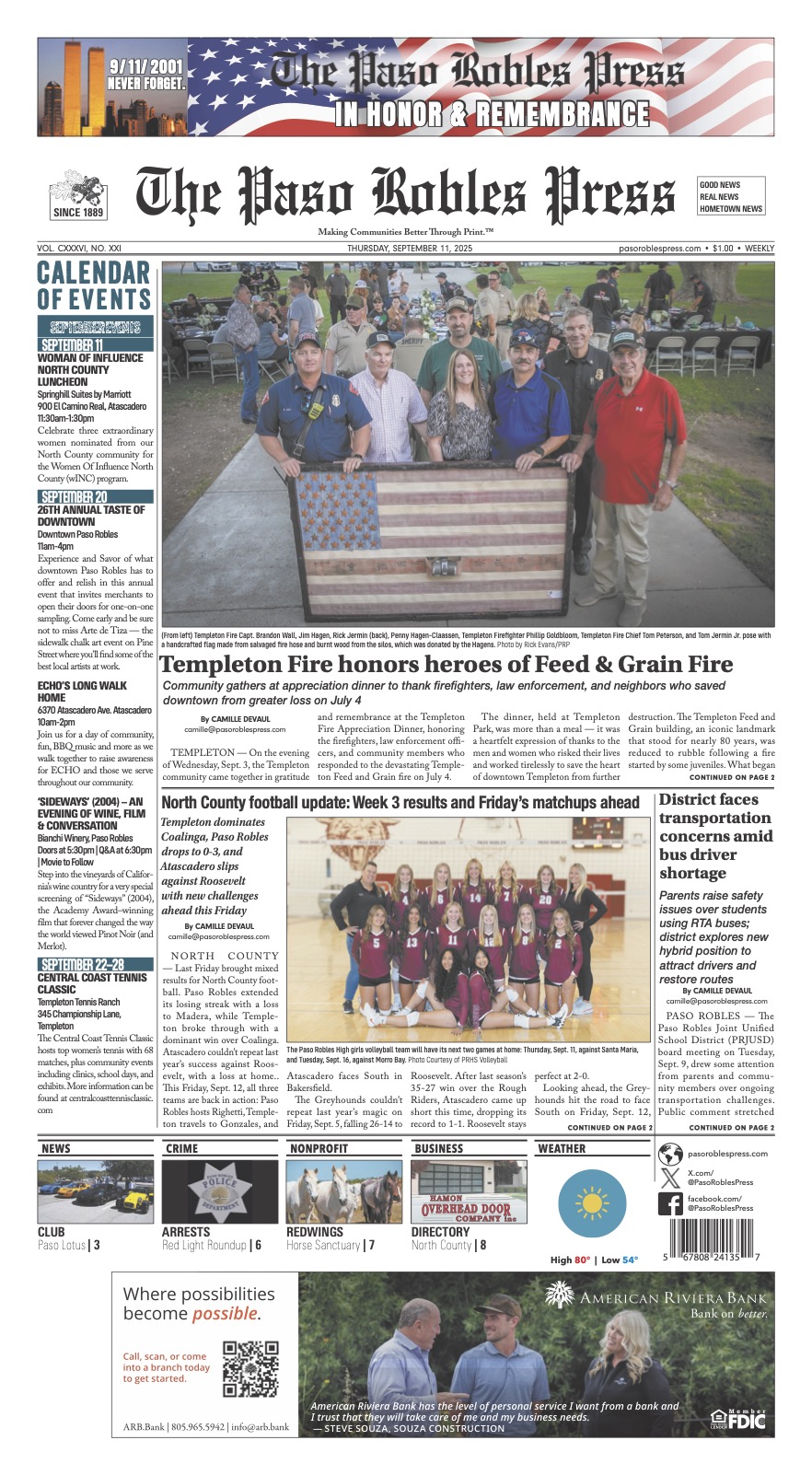Emergency Services Community Workshop discusses fire safety and emergency response
An audience of City staff and concerned residents gathered in the Paso Robles Public Safety Center on August 2, at a workshop on emergency services to assess current levels of first-response to fire and medical emergencies in the community and to consider a strategy in long-term planning.
Notably attentive at the workshop were finalist applicants for the open Fire Chief position, currently administrated by Interim Chief Phillip Garcia. Formerly of Culver City Fire Department, Garcia’s fire service spans over 30 years. In March, Garcia replaced retiring Chief Ken Johnson while a nationwide search commenced for a permanent leader.

Members of emergency services and planning answer questions and debate topics. Photo credit: Rick Evans
The emergency services panel included firefighters Richard Gallagher (Interim Fire Marshal) and Jonathan Stornetta (Interim Battalion Chief) along with Stu Gary of CityGate and Associates. A retired Livermore-Pleasanton fire chief, Gary has studied the City’s emergency services operations and previously served as a consultant.
Current coverage and staffing
The fire department explained that City resources for fire and emergency medical response community of Paso Robles stretches over 19.9 square miles of varied terrain bisected by a highway, a river, three bridge crossings, and a railroad. Nearly 31,400 residents populate the city, and the General Plan projects a buildout of the city to 44,000 with increasing tourism and proposed residential and hotel development.
Two active fire stations serve the community. Fire Station 1 is located at 900 Park Street in the Public Safety Center. Fire Station 2 operates from a small metal structure at 235 Santa Fe Avenue, near Sherwood and Creston Road. Currently, one battalion chief and six firefighters are assigned per shift.
According to urban fire response protocol, within 10 minutes of a callout, 15 firefighters are needed on-scene to effect 10 functions for a successful outcome of an “offensive attack” of space less than 2,000 square feet. Paso Robles stands at 0.6 firefighters per 1,000 people. In comparison, San Luis Obispo has 1.1 firefighters. Atascadero and Morro Bay supply 0.8 and 0.9 firefighters, respectively.

Members of the community join the open forum to discuss emergency services needs. Photo credit: Rick Evans
The lack of a permanent battalion chief was discussed, as firefighters are forced to multitask to cover the position where necessary. When a battalion chief is unavailable to provide this administrative oversight, a captain must do double duty, reducing efficiency for lack of direct leadership and radio coordination and monitoring.
In 2016, calls for service rose to over 3,600 and units were unavailable 446 times. Instead, mutual aid was needed to fill this void. Attrition and a losses due to budget losses since 2007 stagnated the number of firefighters per shift amid a growing population.
In medical emergencies, newer CPR standards call for more personnel, a minimum of five, to administer CPR for 20 minutes. Unfortunately, the new protocol detains personnel, equipment and vehicles for longer periods, which further challenges a skeleton crew.
Chief Garcia addressed a suggestion of a city-contracted ambulance. “No ambulance can beat our response time at six minutes or less.” He also posed a rhetorical question, “What is the acceptable level of risk for response – is it 80 to 95 percent of the time?”
Mutual aid considerations
The Department explained that Cal Fire, which contracts with municipalities to provide support, is inherently different in that its primary mission is to protect wild land, whereas City of Paso Robles’ primary concern is structure – very different methods of attack. Cal Fire mutual aid costs more, too. Along with a 10 percent fee are higher costs to reflect their prevailing pay scale.
Other firefighting alternatives were discussed, such as merging with neighboring fire departments or creating a public safety department, in which sworn officers serve as both police and firefighters. However, research has shown the latter to be counter-intuitive and training hard to maintain.
City Manager Tom Frutchey expressed interest in studying overtime costs verses hiring firefighters. A supplemental force comprised of seasonal and reserve firefighters was discussed and whether training could match that of full-time staff. Interim Battalion Chief Stornetta proposed a cohesive approach: “Atascadero and Morro Bay ran successful programs. We would want a regional program so we can train together in-house.”
The effect of new construction
New hotels and apartments add demands on first-response resources in the event of an emergency. True, any structure fire call mandates a significant and coordinated response to protect lives, put out fires and preserve surrounding land and structures, but how might hotels and apartments affect current and future resources?
The Transient Occupancy Tax (TOT) is implemented at the rate of 10% and collects $4 million annually for an existing 1,413 rooms. These monies, which are deposited into the General Fund benefits the City’s annual operating budget, includes emergency services funding, which benefit both new and existing structures throughout the community.
Already approved, future construction includes 418 new hotel rooms, and will generate $762,850 annually in TOT funds. Another 757 rooms in the permit process would bring the total to 1,175 new rooms. Add 235 apartment units, 101 single-family residences and 101 beds for assisted living that are awaiting construction and an RV park in the works at 324 spaces.
How might new construction affect the City’s ability to adequately protect them? Consultant Stu Gary explained that modern building codes and materials, such as sprinklers and fire walls, help to effectively mitigate danger, but underscored that state law requires certificated testing every five years. To effect this, a fire marshal and a preventative program would be necessary to properly oversee inspections. “Oversight is what is needed,” said Gary, “as well as building codes.”
A third fire station
A recurring discussion was the lack of a third station to cover the Paso Robles east side, which would elevate daily staffing levels and response capabilities. “Geographically,” said Councilman John Hamon, “the Golden Hill area is the center of Paso Robles.” As construction widens eastward with business and residential structures, it has become more visibly apparent.
The Council and fire personnel agreed that a third station would be extremely cost-prohibitive until more funds are available. Councilman Gregory expressed more details of what it would take to make a third station feasible. Councilman Hamon, who has served Paso Robles as a 19-year volunteer firefighter and EMT, agreed with Chief Garcia’s suggestion that a seasonal and reserve firefighter program could possibly help the City “get over the hump” until a third station became a reality.
The City Council unanimously agreed to study the matter further and reconvene for more discussion.












